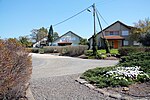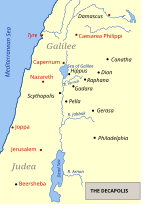Umm el-Qanatir

Umm el-Qanatir, also spelled Umm el-Kanatir (Arabic: ام القناطر, romanized: Umm al-Qanāṭir, lit. 'mother of the arches'), also known as Ein Keshatot (Hebrew: עין קשתות, lit. 'spring of the arches'), is an archaeological site on the Golan Heights, whose main phase is dated to the mid-5th–8th centuries. Excavations have revealed a Roman-period settlement, first inhabited by pagans and later by Jews, who left behind the ruins of an exquisite synagogue when they abandoned the town after it being destroyed by the catastrophic 749 earthquake. The site is located 10 kilometres east of the Dead Sea Transform, one kilometre southwest of Natur.Identification attempts based on Jewish sources have led to two possible ancient names: Kantur, mentioned by Rabbi Menachem di Luzano in his book Ma'arikh (16th/early 17th century); and Qamtra, the name of a place mentioned in the Talmud and with a Jewish past dating back to the Byzantine period.
Excerpt from the Wikipedia article Umm el-Qanatir (License: CC BY-SA 3.0, Authors, Images).Umm el-Qanatir
Syrian Bridge, Golan Regional Council
Geographical coordinates (GPS) Address Nearby Places Show on map
Geographical coordinates (GPS)
| Latitude | Longitude |
|---|---|
| N 32.8497 ° | E 35.737827777778 ° |
Address
אום אל קנטיר
Syrian Bridge
Golan Regional Council
North District, Israel
Open on Google Maps





